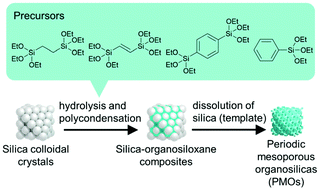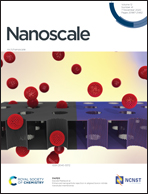Preparation of periodic mesoporous organosilica with large mesopores using silica colloidal crystals as templates†
Abstract
Organosiloxane-based mesoporous materials with periodically ordered pores (periodic mesoporous organosilica, PMO) have many applications due to their various organic functions, high surface areas, and large pore volumes. Conventional methods using surfactant templates (soft templates) are limited in terms of the diversity of organosilane precursors and precise control over the pore size in a relatively large mesopore region (10–50 nm). This paper demonstrates the preparation of PMOs with precisely controlled pore sizes (>10 nm in diameter) and various organosiloxane frameworks, using colloidal crystals of monodisperse silica nanospheres as a template. An inverse opal structure with interconnected spherical mesopores was obtained through polycondensation of hydrolyzed organoalkoxysilanes [(EtO)3Si-R-Si(OEt)3, R = C2H4, CH![[double bond, length as m-dash]](https://www.rsc.org/images/entities/char_e001.gif) CH, and C6H4; PhSi(OEt)3], within the voids of silica colloidal crystals, followed by the preferential dissolution of silica under well-controlled basic conditions. The pore size varied depending on the size of the silica nanospheres. The versatility of this method will allow for the wide tuning of the physical and chemical properties of organosiloxane-based mesoporous materials.
CH, and C6H4; PhSi(OEt)3], within the voids of silica colloidal crystals, followed by the preferential dissolution of silica under well-controlled basic conditions. The pore size varied depending on the size of the silica nanospheres. The versatility of this method will allow for the wide tuning of the physical and chemical properties of organosiloxane-based mesoporous materials.

- This article is part of the themed collections: Nanoscale 2021 Lunar New Year Collection and 2020 Nanoscale HOT Article Collection


 Please wait while we load your content...
Please wait while we load your content...